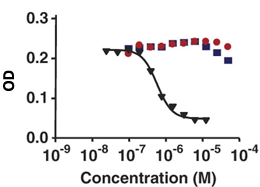Research Abstract
結核菌での化学スクリーニングで見つかった、in vivoでは有効でない炭素源依存性増殖阻害物質
A chemical genetic screen in identifies carbon-source-dependent growth inhibitors devoid of efficacy
2010年8月24日 Nature Communications 1 : 57 doi: 10.1038/ncomms1060

抗菌剤候補となる化合物は通常、そのin vitroでの活性によって同定される。しかし、ほとんどの培養条件はin vivo感 染に相当する環境を再現できないために、新しいリード化合物がもつようにみえる阻害活性が間違いを引き起こす場合がある。我々は、新規抗結核薬のスクリー ニングを行っていた際に、炭素代謝が抗菌薬活性にどのように影響を与え得るかを明らかにしたので報告する。新規なピリミジン–イミダゾール類(PI)が、 結核菌( Mycobacterium tuberculosis )に対する全細胞スクリーニングで見つかった。リード化合物の最適化によって、in vitroでは効能のある、望ましい薬物動態学的性質をもつ誘導体が作出されたが、これはin vivoで は効能がみられなかった。作用機作の研究から、このPI活性はグリセロール代謝と結びつけられたが、グリセロール代謝は感染中の結核菌とは関係のない過程 である。PIは、グリセロールリン酸の蓄積とATPの迅速な枯渇を促進して、結核菌の自家中毒を誘導した。この研究は、新規抗生物質を合理的に発見するた めの前提必要条件として、in vivoで中心となる細菌の代謝系の解明と、使用するin vitro培養条件における的中率の算出が重要であることを明確に示している。
- ノバルティス熱帯病研究所(シンガポール)
Candidate antibacterials are usually identified on the basis of their in vitro activity. However, the apparent inhibitory activity of new leads can be misleading because most culture media do not reproduce an environment relevant to infection in vivo. In this study, while screening for novel anti-tuberculars, we uncovered how carbon metabolism can affect antimicrobial activity. Novel pyrimidine–imidazoles (PIs) were identified in a whole-cell screen against Mycobacterium tuberculosis. Lead optimization generated in vitro potent derivatives with desirable pharmacokinetic properties, yet without in vivo efficacy. Mechanism of action studies linked the PI activity to glycerol metabolism, which is not relevant for M. tuberculosis during infection. PIs induced self-poisoning of M. tuberculosis by promoting the accumulation of glycerol phosphate and rapid ATP depletion. This study underlines the importance of understanding central bacterial metabolism in vivo and of developing predictive in vitro culture conditions as a prerequisite for the rational discovery of new antibiotics.

